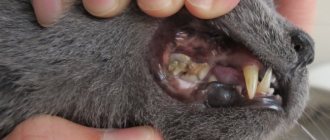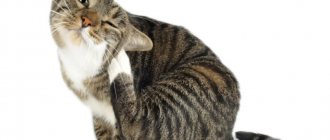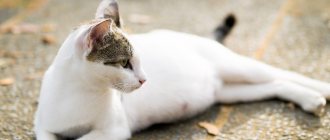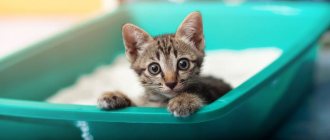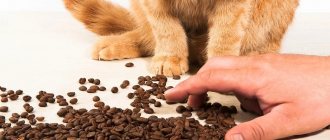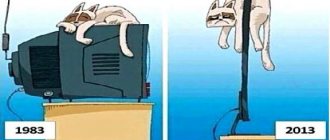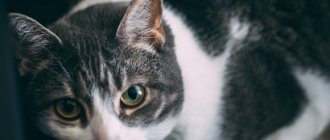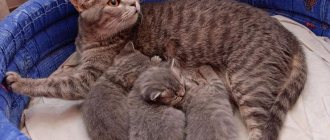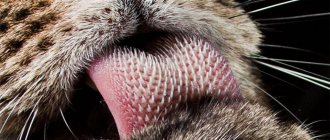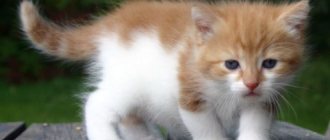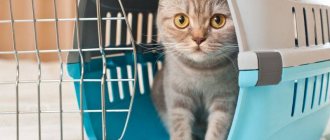Food is a source of proteins, fats, carbohydrates and many vitamins necessary for the proper development of the body. Their deficiency leads to serious illness, decreased activity, premature aging, exhaustion and other problems. Often, refusal to eat is a sign of malaise and pathological processes occurring in the body. It is important for the owner to notice the lack of appetite in his pet in time and, if necessary, urgently contact a specialist.
Reasons for a cat refusing to eat
Refusal to feed is not always a sign of illness. It is important not to panic and correctly analyze the situation.
Reasons for refusal:
- Weather. High temperatures are difficult to tolerate not only for people, but also for cats. Often animals become less active because it is difficult for the body to function in such conditions. Lack of movement reduces the need for food. The pet may not eat for several days. There's nothing wrong with that. The main thing is to provide access to plenty of fresh water and shade.
- Stress. Moving, losing a favorite toy, relatives coming to stay, a conflictual atmosphere in the house - all this can easily traumatize the tender soul of a fluffy. He may stop eating and become active. During this period, try to isolate him from unfavorable factors and please him with something. The veterinary pharmacy and pet store Gomeovet will help you choose interesting toys so that your cat can more easily cope with a stressful situation.
- Changing your diet. Often, owners like to change food, but do not prepare their pet for this. Each cat gets used to its own diet. If she has been fed store-bought food for a long time, she is unlikely to be able to quickly get used to eating porridge and raw meat. Remember that everything needs to be approached gradually.
- Individual characteristics of the body. Before giving birth and during heat, animals may also refuse to eat. This is absolutely normal. It seems that the body, on the contrary, should want to eat more and save energy, but no. The hunger center in the central nervous system is switched off. Exactly those parts of the brain that are important to the animal during this particular period begin to be excited. But if the cat refuses to eat for a long time, and its condition noticeably worsens, then it is better to consult a doctor.
These were, perhaps, reasons that should not cause concern to the owner. But, unfortunately, not only these 4 points make our friends refuse to eat. There are much more dangerous moments:
- Gastrointestinal diseases. Ulcers, erosions, inflammations, tumors, sore teeth, problems in the TMJ, internal bleeding - all this is not the entire list of what can cause illness in your pet. Often such problems are accompanied by a large bouquet of other symptoms, ranging from decreased activity to bloody stools.
- Parasites. Helminths and fleas can easily undermine the health of your furry. They cause vomiting, diarrhea, and loss of appetite. Therefore, it is important to periodically give your pet antiparasitic drugs after consulting a specialist.
- Poisoning. Typically, cats that live in apartments rarely encounter any problems, but it is still possible. The pet could eat something from the table, inhale household chemicals, taste watercolors or face cream. Poisoning is accompanied by diarrhea, vomiting, loss of appetite, and decreased physical activity.
- Foreign bodies. Whose cat doesn't like to eat rain from the Christmas tree? Some pets are ready to feast on thread, ear sticks, hair ties, bottle caps and small toys at any time. They can cause gastrointestinal irritation, obstruction, pain and malaise.
- Viruses. Colds. Just like in humans, an animal’s appetite disappears when it has a cold. The body is trying to force all its reserves to work for recovery; it simply has no time to digest anything. Energy supply is limited!
- Organ diseases. The animal usually feels unwell and in severe pain. The hunger center turns off. This often happens with diseases of the urinary system.
Why do I lose my appetite?
Lack of appetite is not always a deviation and requires the intervention of the owner. Cats can set a “fasting period” for themselves once every 2-3 months. At the same time, water consumption does not stop.
Reference! The norm for fasting while maintaining good health and activity for an adult is considered to be 2-5 days, for a kitten - 1 day.
A pet’s refusal to eat may be a consequence of external factors, body characteristics or diseases. In any case, it would be a good idea to consult a veterinarian.
How to increase your cat's appetite
Dehydration (dehydration) in cats is a lack of water in the body, which jeopardizes the functionality of the animal’s organs and systems. Insufficient intake or excessive loss of fluid leads to the development of life-threatening conditions. You can read more about dehydration in our separate article.
How to help a cat?
Monitoring your cat's diet is very important. This can help avoid serious illnesses and other serious problems.
If you are sure that refusing to eat is not associated with any pathologies, then you can try on your own:
- Protect the animal from stress and ensure proper rest. Let them get used to the new environment, if necessary.
- Buy new interesting toys.
- Try to return to the old diet and begin to introduce a new one again, but gradually.
- Provide living things with plenty of water.
- Do not let the cat stay in the sun for a long time or just in a stuffy room.
Remember that in case of any ailment it is better to consult a specialist. The sooner you do this, the better. Only a doctor can correctly and quickly diagnose and prescribe treatment. Wasted time threatens to lead to irreparable consequences. The veterinarian at the clinic has high-quality equipment that can thoroughly diagnose pathologies. Visit your doctor and protect your pet from pain and complications. Caring for a pet means caring for its health.
What can't you do?
If a cat does not want to eat, it is not recommended to disturb him, especially touching his tail. At the same time, it is important to pay attention to the pet so that it knows that the owners are nearby and care about it. It is not recommended to allow loud noises and scandals, which can cause additional stress for the pet. Owners should not leave the cat's food and drink bowl in the air, so it should be washed daily with special products. If you do not want to eat, it is prohibited to carry out independent treatment and prescribe various medications without the knowledge of the veterinarian.
Esophagostomy
An esophagostomy should be considered whenever the patient either has anorexia or is unable to eat for any reason (eg, severe maxillofacial trauma, neoplasm). Esophagostomy tubes are easy to place, require minimal equipment, and can be used immediately. Esophagostomy is contraindicated in patients who are unable to protect their airway, those with vomiting or regurgitation, or those with functional or mechanical esophageal abnormalities such as megaesophagus or stricture (3). Placing an esophagostomy requires anesthesia, but usually not as deep as that used for surgical interventions. The patient must be sufficiently anesthetized to place the speculum in the mouth without being able to bite.
Depending on the method used and the size of the patient, an 8–20 Fr catheter is selected. The large diameter of these catheters makes it possible to opt for crushed recovery diets, sometimes even without dilution with water. They are also convenient for owners to provide nutritional support to their pets, as long as vomiting does not occur. For cats with chronic kidney disease, an esophagostomy tube can provide another method of fluid delivery and even replace the uncomfortable, stressful procedure of infusing fluid into the subcutaneous space. Once the stitches are removed, the tube can simply be pulled out. It is recommended to treat the exit hole as a wound that heals by secondary intention. You can also apply a simple bandage in the first 12 hours after the stitches are removed. Complications associated with esophagostomy tube placement include dislodgement of the tube due to vomiting or removal by the patient, cellulitis around the introitus, and biting off the end of the tube by the patient after vomiting (1).
Gastrostomy
Gastrostomy tubes are used for long-term nutritional support in seriously ill animals. Gastrostomy tubes can fairly easily provide formula to chronically ill or anorexic patients over many weeks or months (6). The gastrostomy tube delivers nutrition distal to the esophagus, making enteral nutrition possible in patients with esophageal diseases. Gastrostomy is well tolerated, allows bolus feeding, and is intended for long-term feeding at home (2). The gastrostomy allows the patient to eat normally and helps transition the animal to normal feeding before its removal. Gastrostomy placement can be performed surgically or percutaneously. Percutaneous gastrostomy can be placed with or without an endoscope (5). Major complications associated with gastrostomy include injury to the visceral peritoneum during percutaneous placement and peritonitis due to gastric contents entering the peritoneal cavity due to dislodgement or exposure of the tube. As with any surgically placed feeding device, cellulitis and infection at the insertion site are possible (2).
Jejunostomy
Small diameter probes can be placed directly into the proximal jejunum. Feeding distal to the pylorus makes enteral nutrition possible for animals unable to tolerate feed through the stomach. Indications for jejunostomy placement include gastroparesis, uncontrolled vomiting, pancreatitis in dogs, and failure to protect the airway. The most common method of jejunostomy placement is surgical via laparotomy, although transpyloric placement of nasojejunal and gastrojejunal tubes has been described. Jejunostomies are used for a relatively short period (days to weeks) (2). Feeding should be continuous feeding (CI). Bolus administration of formula may cause cramping and diarrhea (5). Complications associated with jejunostomy include peristomal cellulitis or infection, peritonitis secondary to stoma leakage, retrograde tube migration, bowel obstruction due to tube migration, and tube occlusion (2).
We return the cat's appetite
Pay attention to how much your cat doesn't eat. If there is no appetite for less than a day, there is no need to sound the alarm: perhaps by the evening the pet will come to its senses. However, be careful with small kittens: such a period of fasting is deadly for them.
Check to see if your cat has a fever: loss of appetite often accompanies it. If the cat is not sick, but just being mischievous, try these techniques:
- Check to see if the cat's food has spoiled and if it smells good. Animals smell better;
- Wash bowls thoroughly to remove foreign odors;
- Change the contents of the bowl - the food may have become stagnant;
- Check to see if your cat has been eating in secret. Perhaps he was fed by other family members;
- Offer your cat a treat. Maybe the bad guy just wants something tasty.
Digestion stimulation
When the digestive system is functioning well, increased appetite is often observed. You can improve digestion in simple and accessible ways:
- include low-fat fermented milk products in small quantities in your diet;
- use catnip, seaweed, brewer's yeast and other nutritional supplements;
- On an empty stomach, give the animal raw yolk.
If problems with eating food are caused by problems with the digestive system, you can replace regular food with medicinal food. In this case, you should consult your doctor. Medicinal food should be given for a short period of time.
For anorexia (severe weight loss), the animal is prescribed medications. Only a veterinarian should select them, since all medications have contraindications and side effects.
